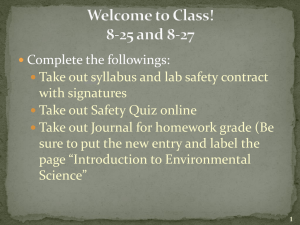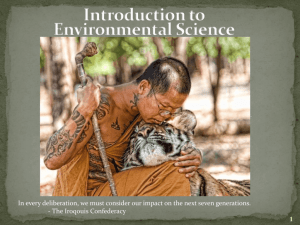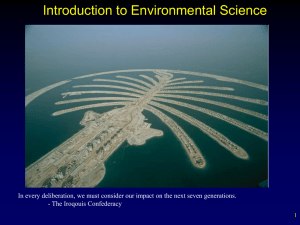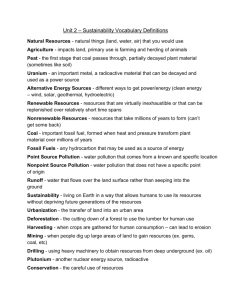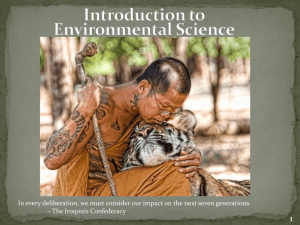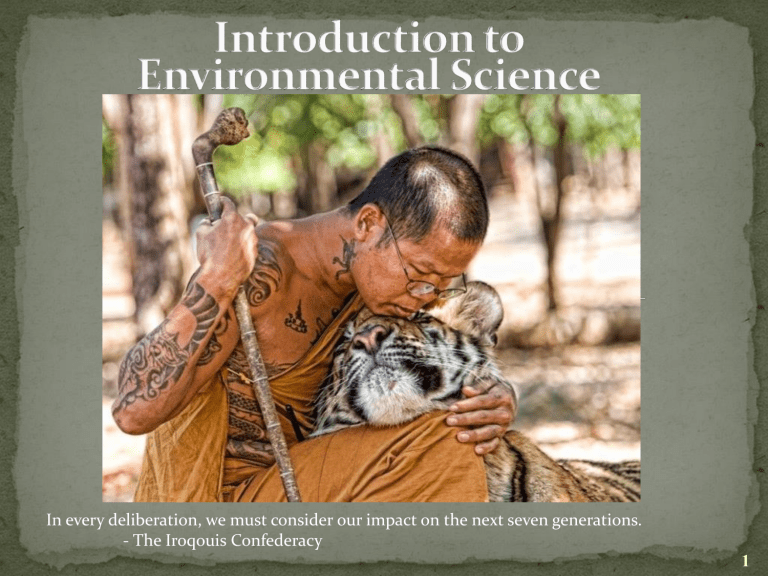
In every deliberation, we must consider our impact on the next seven generations. - The Iroqouis Confederacy 1 Yosemite National Park is a national park directly east of San Francisco that was created in 1890. Source: http://www.nps.gov 3 The city of San Francisco experienced a tremendous population boom in the 19th century due to the gold rush. A powerful earthquake struck the city in 1906, followed by a devastating fire. The city’s water pipes were so damaged by the earthquake, that firefighters were not able to tap fire hydrants. Source: California State Library 4 As the city rebuilt, planners began looking for ways to address some of the issues with the city’s infrastructure, including the water supply. 5 Source: http://sierranevadaphotos.com The city applied to the federal government to construct a reservoir in the Hetch Hetchy valley of Yosemite National Park. An act of Congress and President Woodrow Wilson’s approval were needed for the dam and reservoir to be constructed. 6 Environmental science is the study of the interaction of humans with the natural environment. The environment includes all conditions that surround living organisms: Climate Air and water quality Soil and landforms Presence of other living organisms 7 Environmental science and the issues that it studies are complex and interdisciplinary. Includes concepts and ideas from multiple fields of study. Decisions have impacts in all these fields of study. Source: Principles of Environmental Science, Cunningham, 2005. 8 A community decides to use coal for electricity, as it is the cheapest source available. (Economics) The coal must be mined from under the soil. (Geology) The coal must be transported to the population center by road or rail. (Engineering) When it is burned at a power plant, air pollution is released. Some of that pollution is converted to acid in the atmosphere. (Chemistry) This falls as acid rain somewhere downwind. (Meteorology) The acid stresses plants by affecting their nutrient absorption. (Ecology) Laws are passed requiring the plant to install pollution scrubbers. (Politics) 9 Resource Depletion A great deal of resources are needed to support the human population (~7 billion). Renewable resources can be replenished within a human lifetime. Timber, water. The supply of nonrenewable resources is replenished extremely slowly, if at all. These can be used up. Coal, oil, minerals. 10 Coal is a nonrenewable resource. Over time, it will become more difficult and expensive to extract. This graph represents world coal reserves as of 2008. It is estimated we have about 250 years of the resource remaining at current rates of use. 11 Pollution Pollution is a degradation or an undesired change in air, water, or soil that affects the health of living things. Biodegradable pollution will break down naturally over time. Nondegradable pollution does not break down. 12 Pollution, whether in air or water, can move and affect ecosystems far away from the source. This map shows the areas with the highest concentrations of air pollution. 13 Loss of Biodiversity The number of species on the Earth is unknown, but estimated to be in the tens of millions. Biodiversity is the number of different species present in one specific ecosystem. Extinction, or the complete loss of a species, is a natural event that can be accelerated by human actions. 14 There are five known major extinction events in Earth’s history. The most recent major extinction, about 65 million years ago, caused 75% of all species to disappear from the Earth. Believed to have been caused by a meteor impact. 15 Assuming no catastrophic events occur, extinctions normally occur at a pretty slow rate, called the background rate. Normal background extinction rate for mammals is 1 every 200 years. Scientists believe we may be in the midst of the next major extinction event, due to human influences. Australia has experienced 27 mammal extinctions since 1788, primarily due to the influence of European settlers. The short-tailed hopping mouse, now extinct in Australia. 16 Environmental ethics is the discipline that studies the moral relationship of human beings to the environment. What is the value of the environment? What moral responsibility do we have in dealing with the major environmental problems that result from our resource consumption? Which needs should be given the highest priority in our decision making? Two main categories of ethics have emerged in human culture in modern history. 17 Anthropocentrism literally means “human-centered”. This set of ethics protects and promotes of human interests or well-being at the expense of all other factors. Often places an emphasis on short-term benefits while disregarding long-term consequences. 18 Ecocentrists believe that nature deserves to exist for its own sake regardless of degree of usefulness to humans. The preservation of ecosystems or other living things takes priority over human needs. 19 The debate about whether to build a dam in the Hetch Hetchy valley was one of the first big debates between these two philosophies. Anthropocentrists argued that San Francisco needed the water, and this was by far the most viable option. Ecocentrists argued that this violated the very purpose of the Federal Parks were to be preserved ecosystems – untouched by human hands. 20 The dam was eventually constructed. The justification for building it was best stated by Gifford Pinochet, the first man in charge of the U.S. Forest Service. "Where conflicting interests must be reconciled, the question shall always be answered from the standpoint of the greatest good of the greatest number in the long run.“ This philosophy, called resource conservationism, was also advocated by Teddy Roosevelt. 21 22 The focus of the resource conservationists was to protect open land. The National Parks system, and the National Forest system were both created during this time. 23 In 1952, the Cuyahoga river in Ohio caught fire due to all the pollution that had accumulated in it. Rachel Carson published a book in 1962 entitled Silent Spring about the effects of pesticides on large predatory birds, particularly the bald eagle. This began a public awakening to threats of pollution and toxic chemicals to humans as well as other species. This movement is called Modern Environmentalism. 24 Increased travel and communication enables people to know about daily events in places unknown in previous generations. Global environmentalism explores issues and problems over the entire world, not just within the local community. Live streaming footage of the Deepwater Horizon oil spill in 2010 was watched worldwide. 25 A great deal of progress has been made since the birth of modern environmentalism, but many debates still rage on. An ecologist named Garrett Hardin wrote an essay called “The Tragedy of the Commons”, describing the source of environmental problems as a conflict: Short-term interests of individuals versus… Long-term interests of civilization and the Earth itself 26 A small village consists mostly of farmers that raise and sell sheep at a nearby city. The only place for the sheep to graze is a commons in the center of the village. A commons is an area that belongs to no individual; it is shared by the entire society. Likely outcome: Villagers obtain as many sheep as possible, allow to graze in the commons. Maximize short-term financial gain. 27 What if the commons was instead divided into sections that was owned by each villager? Because the land is owned, individuals are much more likely to plan and use it for the long-term. 28 The Tragedy of the Commons describes the likeliness of a commons area being exploited for short-term economic gain. Modern examples include the atmosphere and oceans. Norilsk, Russia Source: ecojunk.wordpress.com Zadar, Croatia Source: Agence France-Presse 29 Economics has a huge influence in environmental decision-making. One of the most basic principles of economics is supply and demand. The greater the demand for a limited resource, the higher the price. 30 Another important economic idea is the cost/benefit analysis. This questions whether the benefit of doing something justifies the economic cost. Waukegan Harbor cleanup efforts, starting in 2010, will cost over $30 million. Monitoring of fish, water, and sediment. Dredging the bottom to remove accumulated pollution. 31 In December of 1984, a pesticide factory located near the town of Bhopal, India leaked a large amount of toxic chemicals into the air. The chemicals resulted in an immediate death toll of about 3,000 people, with 8,000 more dying of longterm health ailments. A total of 558,125 injuries were reported to the Indian government. A settlement of $470 million was reached by Union Carbide and the Indian government. 32 The settlement was not sufficient to treat all of the long- term health issues stemming from the disaster. The site itself was also not remediated. In 1999, Union Carbide was purchased by Dow Chemical. To properly compensate and treat all individuals affected by this disaster, Dow Chemical would have to pay billions of dollars in settlements. Dow Chemical has a yearly profit of over $2 billion, with total assets worth nearly $70 billion. 33 The Yes Men Fix the World. Dir Andy Bichlbaum, Mike Bonanno. Charny/Bacharach Entertainment, 2009. 34 One of the factors that led to the Bhopal disaster and lack of cleanup is that at the time, India was a developing country. Developing countries have lower incomes, shorter life spans, and rapid population growth. Developing countries, overpopulated and desperate for economic gain, tend to have less regulations on their industries and fewer environmental protections. 35 Developed countries on average have higher incomes, longer life spans, and slower growth rate. These countries are more economically stable, educated, and have more environmental protections. 36 Developed countries, while smaller in size and growth, consume resources at a greater rate. About 20% of the world’s population uses 75% of its resources. 37 U.S. Japan Mexico Indonesia Life Expectancy 77 81 71.5 68 Population Growth Rate 0.8% 0.2% 1.7% 1.8% Gross National Product Per Person $29,240 $32,350 $3,840 $640 Energy Use Per Person 351 (Millions of BTUs) 168 59 18 Carbon Dioxide Produced Annually Per Person 20.4 9.3 3.5 2.2 Garbage Produced Annually Per Person 720 400 300 43 Source: Holt Environmental Science, Arms, 2007 38 Many products used in developed countries are produced in developing countries. Working conditions and pay in these countries is often at levels that would be unacceptable elsewhere. A collapsed garment factory in Savar, Bangladesh. Source: AP 39 StarKist brand chunk light tuna in water Price at Jewel-Osco grocery: $0.99 American Tuna brand wild albacore tuna in water Price at Whole Foods market: $4.99 What are the hidden costs behind that $4.00 price difference? 40 An ecological footprint is one measurement of a person’s resource use. Includes the amount of space needed to support each person in a nation, including forests, farms, cities, etc. Developed countries have a much larger footprint, reflecting a much larger use of resources. 41 Sustainability is when human needs are met so that the population can survive indefinitely. “Meeting the needs of the present without compromising the ability of future generations to meet their own needs.” Brundtland Commission, 1987 42 The Earth is a closed system, meaning nothing enters or leaves the Earth in large quantities is heat. Resources are limited, but the population continues to increase. Wastes do not go away. “We travel together, passengers on a little ship, dependent on its vulnerable reserves of air and soil.” “Earthrise” taken by Apollo 8 crew, 1968. - Adlai Stevenson 43
